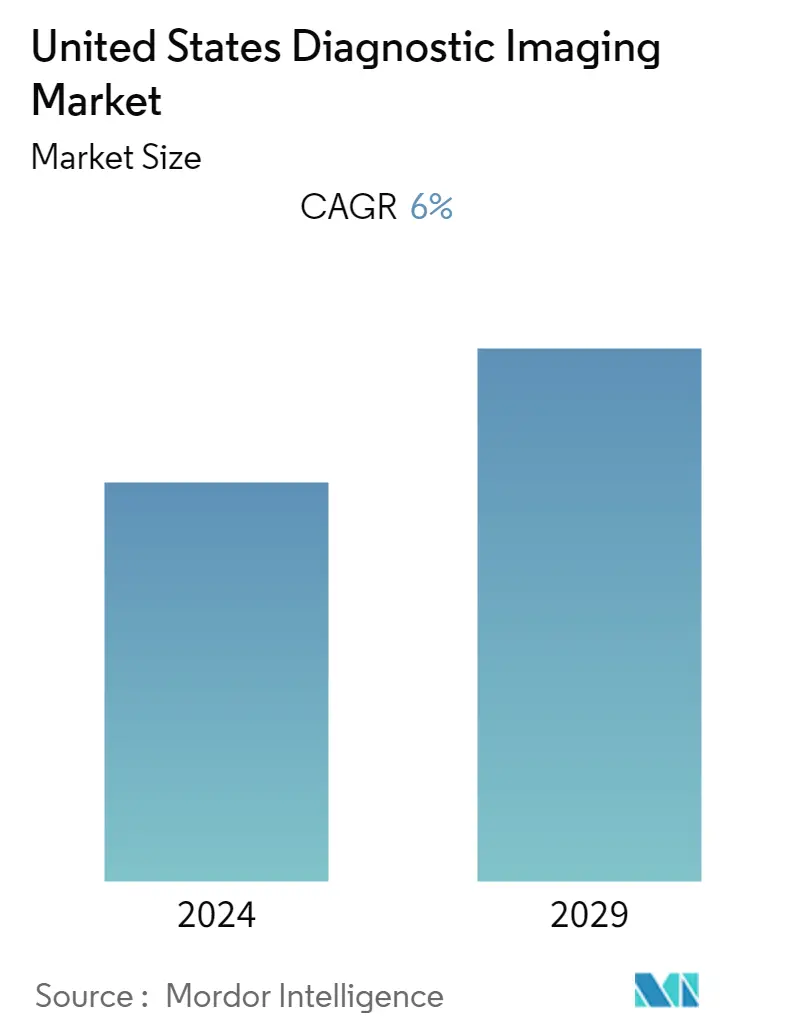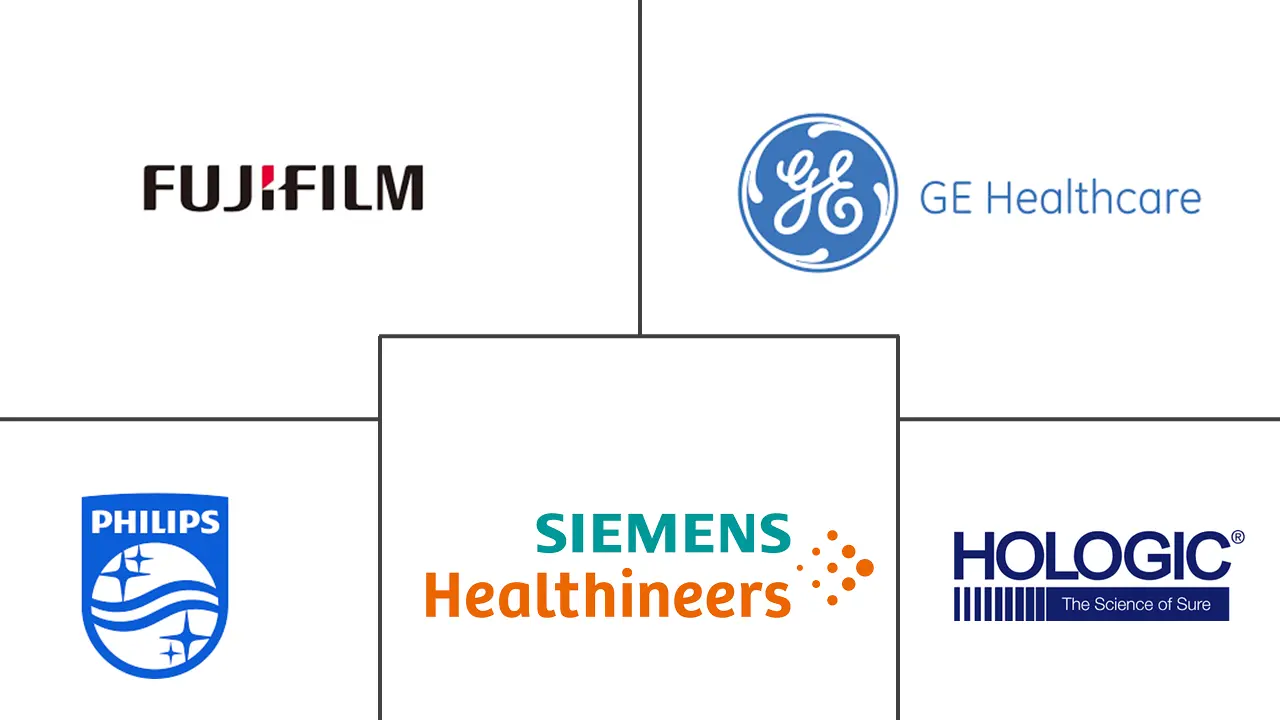Market Size of United States Diagnostic Imaging Industry

| Study Period | 2019 - 2029 |
| Base Year For Estimation | 2023 |
| Forecast Data Period | 2024 - 2029 |
| Historical Data Period | 2019 - 2022 |
| CAGR | 6.00 % |
| Market Concentration | Medium |
Major Players
*Disclaimer: Major Players sorted in no particular order |
United States Diagnostic Imaging Market Analysis
The United States diagnostic imaging market is expected to register a CAGR of nearly 6.0% during the forecast period (2022-2027).
The COVID-19 pandemic is expected to have a significant impact on the United States diagnostics imaging market owing to the decline in the number of imaging procedures performed in the country due to the high infection rate of the COVID-19 and the decline in footfall in the hospitals and diagnostics centers. For instance, as per the August 2020 report of the Department of Radiology, the New York University Langone Health was performing more than 2 million imaging examinations per year before the COVID-19 pandemic, but the number of procedures declined significantly during the COVID-19 pandemic. Further, in April 2020, the American College of Radiology (ACR) issued guidance recommendations specifying that radiologists diagnosing COVID-19 patients should only use diagnostic imaging equipment only when it is necessary. Furthermore, the guidance recommended that the usage of equipment, like MRI and CT scans, should be temporarily halted to curb the contamination with the virus through diagnostic equipment. However, with the potential negative impact of COVID-19 on lungs and other body parts, the use of computed tomography (CT) and magnetic resonance imaging (MRI) increased later with some research and recommendations. For instance, in April 2021, researchers from the Thomas Jefferson University in Philadelphia stated that chest X-ray imaging can potentially help providers prepare for the type of care a patient will need in COVID-19. Therefore, COVID-19 is expected to have a significant impact on the studied market over the forecast period.
The major factors driving the United States diagnostic imaging market include the technological advancement in imaging modalities, growing awareness regarding preventive care, the rising number of diagnostic imaging centers, the increasing prevalence of chronic diseases, and the increasing geriatric population. The United States is expected to experience an accelerated rate of the aging population, as compared to many other developed countries. In January 2022, an article published titled "The Economics of an Aging Population" stated that around 54 million (16.5% of the country's total population) people are over the age of 65 in the United States and by 2030, this number be projected to reach 74 million, with the fastest-growing group is those over 85, and as the geriatric population is more prone to various chronic diseases such as cardiovascular diseases, musculoskeletal and neurodegenerative disorders, cancer and other diseases, the demand for diagnostics imaging is expected to increase in the country which is expected to fuel growth in the diagnostics imaging market in the United States over the forecast period. In addition, according to the June 2022 update of the Centers for Disease Control and Prevention, one or more chronic diseases, such as diabetes, cancer, heart disease, and stroke, affect six out of ten Americans. These and other chronic illnesses are the main contributors to health care costs as well as the major causes of death and disability in the United States. Hence, the high burden of chronic diseases and the increasing geriatric population is expected to play a significant role in the growth of the studied market.
Additionally, the technological advancements in imaging technology by the key market players in the area coupled with the launch of new products, mergers, and acquisitions, collaborations are further expected to play a crucial role in the growth of the diagnostics imaging market in the United States. For instance, in November 2021, FUJIFILM Healthcare Americas Corporation, a subsidiary of FUJIFILM presented its Velocity MRI system which is a high-field open MRI system at the 2021 Radiological Society of North America (RSNA) conference. Therefore, due to the above-mentioned factors, the diagnostics imaging market is expected to grow over the forecast period of the study. However, the lack of skilled professionals and reduction in reimbursement rates are expected to restrain the growth of the United States diagnostics imaging market over the forecast period.
United States Diagnostic Imaging Industry Segmentation
As per the scope of the report, the United States diagnostic imaging market covers diagnostic imaging used to take images of the internal structure of the human body using electromagnetic radiation, for accurate diagnosis of the patient. It has vast applications in a variety of oncological, orthopedic, gastro-, and gynecological fields. The United States Diagnostic Imaging Market is segmented by Product (X-ray, Ultrasound, Magnetic Resonance Imaging (MRI), Computed Tomography, Nuclear Medicine, Fluoroscope, and Mammography), Application (Cardiology, Oncology, Neurology, Orthopedic, Gastroenterology, Gynecology, and Other Applications), and End User (Hospitals, Diagnostic Centers and Other End Users). The report offers the value (in USD million) for the above segments.
| By Product | |
| X-ray | |
| Ultrasound | |
| Magnetic Resonance Imaging (MRI) | |
| Computed Tomography | |
| Nuclear Medicine | |
| Fluoroscope | |
| Mammography |
| By Application | |
| Cardiology | |
| Oncology | |
| Neurology | |
| Orthopedic | |
| Gastroenterology | |
| Gynecology | |
| Other Applications |
| By End User | |
| Hospitals | |
| Diagnostic Centers | |
| Other End Users |
United States Diagnostic Imaging Market Size Summary
The United States diagnostic imaging market is poised for growth, driven by technological advancements in imaging modalities and an increasing awareness of preventive care. The market is experiencing a surge in demand due to the rising prevalence of chronic diseases and a growing geriatric population, which is more susceptible to conditions requiring diagnostic imaging. The aging population in the United States is expected to expand significantly, leading to a higher demand for imaging services to manage chronic illnesses such as cardiovascular diseases, cancer, and neurodegenerative disorders. Despite the challenges posed by the COVID-19 pandemic, which initially led to a decline in imaging procedures, the market is rebounding as the necessity for imaging in diagnosing and managing COVID-19-related complications becomes evident. The MRI segment, in particular, is expected to hold a significant share of the market, supported by technological advancements and its widespread application in diagnosing neurodegenerative disorders.
The competitive landscape of the United States diagnostic imaging market is characterized by the presence of major players like GE Healthcare, Siemens Medical Solutions USA, Inc., Hologic, Inc., Koninklijke Philips NV, and FUJIFILM Holdings Corporation. These companies are focusing on research and development to introduce technologically advanced products that minimize costs and side effects. The market is also witnessing strategic moves such as mergers, acquisitions, and collaborations, which are expected to further drive growth. However, the market faces challenges such as a shortage of skilled professionals and reduced reimbursement rates, which could hinder its expansion. Despite these challenges, the market's growth trajectory remains positive, with ongoing innovations and the introduction of new products like FUJIFILM's Velocity MRI system and Memorial MRI's uMR Omega 3T MRI system contributing to its development.
United States Diagnostic Imaging Market Size - Table of Contents
-
1. MARKET DYNAMICS
-
1.1 Market Overview
-
1.2 Market Drivers
-
1.2.1 Technological Advancement in Imaging Modalities
-
1.2.2 Rising Number of Diagnostic Imaging Centers
-
1.2.3 Increasing Prevalence of Chronic Diseases and Rising Geriatric Population
-
-
1.3 Market Restraints
-
1.3.1 Dearth of Radiologists
-
1.3.2 Reduction in Reimbursement Rate
-
-
1.4 Porter's Five Forces Analysis
-
1.4.1 Threat of New Entrants
-
1.4.2 Bargaining Power of Buyers/Consumers
-
1.4.3 Bargaining Power of Suppliers
-
1.4.4 Threat of Substitute Products
-
1.4.5 Intensity of Competitive Rivalry
-
-
-
2. MARKET SEGMENTATION (Market Size by Value - USD million)
-
2.1 By Product
-
2.1.1 X-ray
-
2.1.2 Ultrasound
-
2.1.3 Magnetic Resonance Imaging (MRI)
-
2.1.4 Computed Tomography
-
2.1.5 Nuclear Medicine
-
2.1.6 Fluoroscope
-
2.1.7 Mammography
-
-
2.2 By Application
-
2.2.1 Cardiology
-
2.2.2 Oncology
-
2.2.3 Neurology
-
2.2.4 Orthopedic
-
2.2.5 Gastroenterology
-
2.2.6 Gynecology
-
2.2.7 Other Applications
-
-
2.3 By End User
-
2.3.1 Hospitals
-
2.3.2 Diagnostic Centers
-
2.3.3 Other End Users
-
-
United States Diagnostic Imaging Market Size FAQs
What is the current United States Diagnostic Imaging Market size?
The United States Diagnostic Imaging Market is projected to register a CAGR of 6% during the forecast period (2024-2029)
Who are the key players in United States Diagnostic Imaging Market?
FUJIFILM Holdings Corporation, GE Healthcare, Koninklijke Philips NV, Hologic, Inc. and Siemens Healthineers are the major companies operating in the United States Diagnostic Imaging Market.

